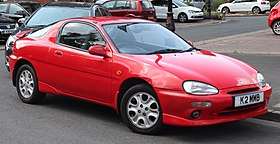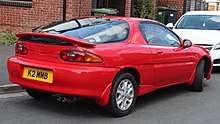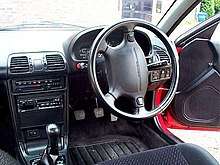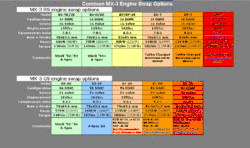Mazda MX-3
The Mazda MX-3 is a four-seat coupé manufactured and marketed by Mazda, introduced at the Geneva Auto Show in March 1991[3] and marketed for model years 1992–1998.
| Mazda MX-3 | |
|---|---|
 1992 MX-3 1.8 | |
| Overview | |
| Manufacturer | Mazda |
| Also called | Mazda MX-3 Precidia Eunos 30X (Australia)[1] Mazda-Eunos 30X (Australia)[1] Eunos Presso Autozam AZ-3 Mazda AZ-3 |
| Production | 1991–1998 |
| Assembly | Hofu, Japan |
| Designer | Takeshi Arakawa (1988)[2] |
| Body and chassis | |
| Class | Compact car |
| Body style | 3-door 2+2 Kammback |
| Layout | FF layout |
| Platform | Mazda EC platform |
| Related | Mazda Familia/323/Protege |
| Powertrain | |
| Engine | 1.5 L B5-ZE I4 DOHC 1.6 L B6-ME I4 SOHC 1.6 L B6D I4 DOHC 1.8 L K8 V6 DOHC |
| Transmission | 5-speed manual 4-speed F4A-EL automatic |
| Dimensions | |
| Wheelbase | 2,455 mm (96.7 in) |
| Length | 4,208 mm (165.7 in) |
| Width | 1,695 mm (66.7 in) |
| Height | 1995-98: 1,321 mm (52.0 in) 1991-95 Base: 1,280 mm (50.4 in) 1991-95 GS: 1,285 mm (50.6 in) |
| Curb weight | RS: 1,095 kg (2,414 lb) GS: 1,171 kg (2,582 lb) |
| Chronology | |
| Predecessor | Mazda Étude |
The MX-3 was also marketed as the Mazda MX-3 Precidia in Canada and as the Eunos Presso, Autozam AZ-3 and Mazda AZ-3 in Japan. In Australia it was marketed as the Eunos 30X until late 1996 when it became the Mazda-Eunos 30X.[1]
History
The MX-3's platform is called the EC platform, and shares much with the BG platform of the contemporary Familia/323/Protegé. The first model year available for most markets, including North America where it went on sale in September 1991, was 1992. Originally available with a single-cam 1.6-liter inline-four or the twin-cam V6, a few more engines were available as development continued. In the summer of 1991, the Autozam AZ-3 was added to the Japanese market lineup.[3] It was known by two names;"Autozam" was meant to be Mazda's more youthful brand, so it combined a somewhat lower price with a sportier (but smaller) twin-cam four of 1.5 liters, and also sold as the Eunos Presso, a companion, affordable sports car to the Eunos Roadster.
The small displacement V6 was offered to comply with Japanese government regulations concerning exterior dimensions and engine displacement; Japanese buyers were liable for annual taxes for vehicles exceeding the regulations and large displacement engines, which would affect sales. Japanese buyers who were willing to pay the tax for larger vehicles were now given a choice of the FC series Mazda RX-7 and the JC series Mazda Cosmo.
In January 1994, a DOHC version of the familiar B6 engine, the B6D, replaced the previous version.[3] This provided a useful power increase but conversely also made the considerably more expensive V6 version less desirable. Sales of the V6 in the United States market came to an end after the 1994 model year, although they continued in Canada, Japan and many other export markets. While called K8-DE in North American specs, Japanese and other markets received an engine called the K8-ZE. Aside from emissions equipment and varying power claims due to myriad ratings methods, the differences are negligible.
Performance
The V6 MX-3 has a factory claimed top speed of 202 km/h (126 mph) in European trim.[4] The US-spec MX-3 GS can accelerate from 0 to 60 mph (97 km/h) in 8.4 seconds, and can travel a quarter mile in 16.4 seconds. With a turning rate of 0.89 g (8.7 m/s²), its handling capabilities were among the best in its class.
The V6 engine belonged to the Mazda K-series, which were used in a range of Mazda vehicles. These engines use a Variable Length Intake Manifold (VLIM), in order to provide optimal torque using intake resonance. Mazda called their system on the MX-3 the "Variable Resonance Induction System" (VRIS). This engine had a 7,000 rpm redline, and a 7,800 rpm fuel cutoff.
For the rear suspension of the MX-3, Mazda used its proprietary Twin-Trapezoidal Link (TTL) technology, delivering benefits associated with active four-wheel steering systems while lighter and less mechanically complicated. Twin-Trapezoidal Link technology has been used on a range of other Mazda vehicles before and since the MX-3.
Models and specifications
- RS • 1992-1998 (North America 1991-1996)
- GS • 1992-1998 (Canada until 1995, US until 1994)

.jpg)

| 1.6L B6-ME SOHC 16-valve[5] | |
|---|---|
| Type | inline-4 |
| Power | 88 hp (66 kW) at 5,000 rpm |
| Torque | 98 lb⋅ft (133 N⋅m) at 4,000 rpm |
| Model years | 1992-1993 |
| 1.6L B6-D DOHC 16-valve | |
|---|---|
| Type | inline-4 |
| Power | 106 hp (79 kW) |
| EPA fuel economy (mpg) | 1994 5MT: 25 city, 28 combined, 34 highway, average 30.0[6] |
| Model years | 1994-1998 |
| 1.8L K8-DE DOHC 24-valve[7] | |
|---|---|
| Type | 60° V6[5] |
| Power | 130 hp (97 kW) at 6,500 rpm |
| Torque | 115 lb⋅ft (156 N⋅m) at 4,500 rpm |
| 0-60 mph (0-97 km/h) | 8.5 s |
| 1/4 mile | 16.8 s @ 82.5 mph (133 km/h) |
| Top speed | estimated 120 mph (125 mph before 7800 rpm cutout) |
| Model years | 1992-1998 |
Special editions
In 1993, Mazda Canada offered a limited special edition model of its Mazda MX-3 GS to celebrate the company's 25th year in Canada. At the same time, Mazda USA offered a similar model in a special edition as well. Only a total of 2,000 were supposedly made. The special edition MX-3 featured the V6 engine, leather interior (including seats, steering wheel and shift knob), heated seats (Canada only), and custom Enkei manufactured 15 inch alloy wheels. Most special edition models came in the color "raspberry metallic"; however, there was also "blaze" red, "brilliant" black, and "laguna" blue.
In 1993, Mazda Europe produced 100 Mazda MX-3 V6 SEs. These had a leather and suede interior, and all had the clear white body color. There were also a limited number of Mazda MX-3 V6 Equipes, with "sparkle green metallic" or "noble" green exteriors.
Modifications

The MX-3 is becoming a rare car, so modifications for it can be difficult to find unless one knows where to look, since it has not been sold in North America since 1997. Since the MX-3 has two engine classes, I4 and V6, many of the engine performance modifications are dependent upon what platform is installed.
There is now a decent range of body modifications for the MX-3 along with performance brakes and suspension. Most extensive modification must be entirely custom fabricated due to limited availability.
RS
The MX-3 RS with the four-cylinder engine can upgrade to the BP 132 hp (98 kW), B6-T 147 hp (110 kW), BP-T 179 hp (133 kW) and BPD-T 206 hp (154 kW) engines.[8]
Swapping of the four-cylinder RS engines is slightly more complicated than the V6 GS mainly due to ECU, wiring harness, and MAF combinations as well as motor mounts. The V6 swaps require specific ECU, intake manifold, and VAF sensor combinations, but there are far fewer variables to deal with. Many improvements can be made after the engine swap and during the engine tuning process to find the best combination of engine peripherals.
GS
The most common engine swap for MX-3 GS owners with the V6 engine is a 2.5 L V6, either a North American-spec KL-DE 168 hp (125 kW), found most commonly in the 1993-1997 Ford Probe GT, the 1993-1997 Mazda MX-6 LS, or the 1993-2002 Mazda 626 LX or ES, and the Japanese-spec KL-ZE 200 hp (149 kW), found in such vehicles as the Efini MS-8, Xedos 9, and Eunos 800. A 2.0 L V6 KF-ZE is also available, but this swap is quite difficult due to the unavailability of required components. For this reason, this particular engine swap is not often attempted.[8][9] The GS, apart from the engine has dual tip exhaust, a tighter steering ratio, four disc brakes and front and rear spoiler.
References
- Mazda-Eunos 30X, New Car Buyers Guide No 9, Universal Magazines, Australia, 1996
- "Automobile". Retrieved 29 October 2018.
- Büschi, Hans-Ulrich, ed. (6 March 1997). Automobil Revue 1997 (in German and French). 92. Berne, Switzerland: Hallwag AG. p. 356. ISBN 3-444-10479-0.
- Büschi, Hans-Ulrich, ed. (10 March 1994). Automobil Revue 1994 (in German and French). 89. Berne, Switzerland: Hallwag AG. p. 356. ISBN 3-444-00584-9.
- Vettraino, J. P. (29 July 1991). "Cutting In At The Head Of The Pack". AutoWeek. Detroit MI: Crain Communications. 41 (30): 18–21. ISSN 0192-9674.
- Fuel Economy of 1994 Mazda Vehicles, www.fueleconomy.gov
- Bornhop, Andrew (November 1991). Bryant, Thos L. (ed.). "Mazda MX-3 GS: A GT amongst the pocket-rockets". Road & Track. Newport Beach, CA: Hachette Magazines. 43 (3): 72–79. ISSN 0035-7189.
- "Engine swap and body modification page". MX-3.com. Retrieved 2010-11-06.
- "KLZE and KLDE Engine Comparison". Webcitation.org. Archived from the original on October 22, 2009. Retrieved 2010-11-06.
External links
| Wikimedia Commons has media related to Mazda MX-3. |
- MX-3.com – Specifications and other details
- UK-MX3.com – UK Owners Club